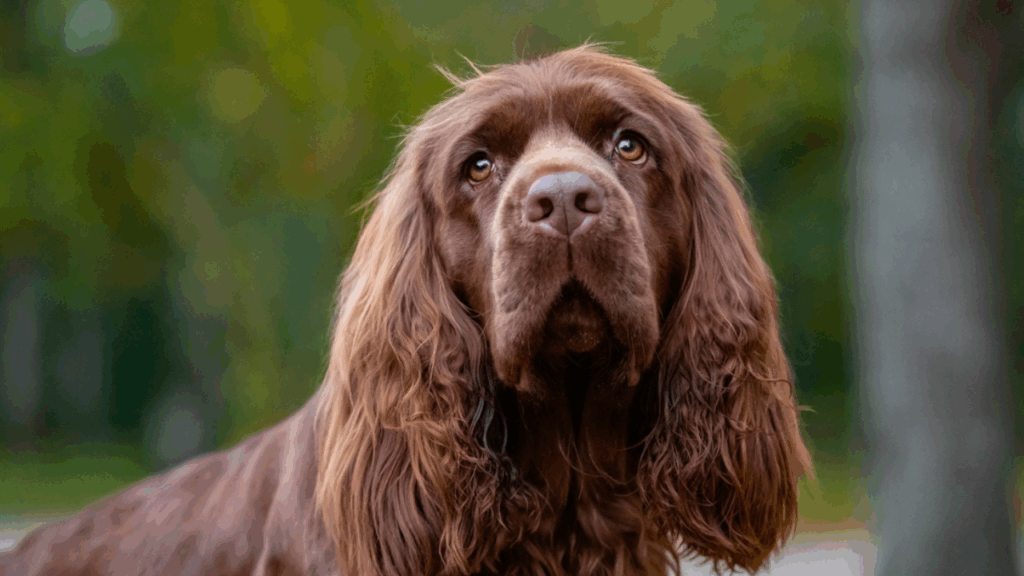The Sussex Spaniel is a distinctive, rare, and charming member of the spaniel family, known for its golden liver coat, soulful expression, and laid-back personality. Unlike some of its more energetic spaniel cousins, the Sussex Spaniel has a calmer demeanor and a steady work ethic, making it a perfect companion for those who appreciate a loyal, affectionate, and even-tempered dog.
Though not as well-known as the Cocker or Springer Spaniels, the Sussex Spaniel has a fascinating history, a dedicated following, and a big heart packed into a low-slung, sturdy frame.
Origins and History
The Sussex Spaniel was developed in the early 19th century in Sussex County, England, hence its name. It was bred by Mr. Augustus Fuller at Rosehill Park to flush game in dense undergrowth. Fuller’s goal was to create a slow-moving, deep-voiced spaniel that could navigate thick hedgerows and communicate with the hunter using its distinctive bark—a trait uncommon in most sporting breeds.
This barking, or “giving tongue,” made the Sussex Spaniel particularly useful in hunting environments where visibility was poor. By the late 1800s, the breed was formally recognized, but its population remained small.
The Sussex Spaniel nearly went extinct during World War II, but a dedicated breeder named Joy Freer preserved the breed by maintaining a small group of dogs. Most Sussex Spaniels today descend from her breeding program.
Although still considered a rare breed, the Sussex has slowly gained recognition in dog shows and family homes alike.
Appearance
The Sussex Spaniel has a distinctive look: low, long, and solidly built, with a rectangular body and short legs. It typically weighs between 35 to 45 pounds and stands around 13 to 15 inches at the shoulder.
Its most defining feature is the rich golden-liver coat, which is unique among all dog breeds. The coat is flat or slightly wavy, dense, and weather-resistant, with feathering on the legs, tail, and ears. Its long, low ears and large, soft brown eyes give it a gentle and almost mournful expression.
Despite its somewhat sad look, the Sussex is full of character and charm.
Temperament and Personality
Unlike many other spaniels known for high energy and exuberance, the Sussex Spaniel is more relaxed and steady. It is known for its gentle, loyal, and affectionate nature. Sussex Spaniels love being around their people and are happiest when they are part of family activities.
They tend to form deep bonds with their families and may become clingy or suffer separation anxiety if left alone for long periods. Their sensitivity means they thrive best in homes where someone is often present.
Though calm indoors, the Sussex retains its hunting instinct and needs regular outdoor exercise to stay healthy and content. They enjoy sniffing around in gardens or woods and are surprisingly sturdy and strong, capable of enduring longer walks and moderate hikes.
They are typically good with children and other pets, especially when raised with them, and their kind demeanor makes them suitable for various household types.
Training and Intelligence
The Sussex Spaniel is intelligent but can sometimes display a stubborn or independent streak, particularly if bored or uninterested. Training requires patience, consistency, and positive reinforcement methods like treats and praise.
Early socialization and obedience training are important, as the breed can be vocal and sometimes assertive if not properly guided. They are also naturally alert and vocal, which, while helpful in hunting, can make them a bit barky at home.
Once engaged, however, Sussex Spaniels enjoy training and mental stimulation, especially activities that tap into their scenting ability.
Exercise Needs
While not as high-energy as other spaniels, the Sussex Spaniel still needs daily exercise to prevent boredom and maintain a healthy weight. A combination of walks, playtime, and scent-based games will keep them mentally and physically satisfied.
Due to their long backs and short legs, care should be taken to avoid excessive jumping or navigating steep stairs, which can strain their spine.
Grooming and Care
The Sussex Spaniel requires regular grooming to keep its coat in good condition. Brushing two to three times a week helps prevent matting and removes debris picked up during outdoor activities. Special attention should be paid to the feathering on the legs, ears, and chest.
Their long ears should be checked and cleaned regularly to prevent infections. Routine nail trimming, dental care, and parasite prevention are also necessary to maintain overall health.
Health and Lifespan
The Sussex Spaniel is a generally healthy breed, with a lifespan of around 12 to 14 years. However, like many purebred dogs, they are prone to certain conditions, including:
- Hip dysplasia
- Intervertebral disc disease (IVDD) due to their long back
- Ear infections
- Heart conditions such as pulmonary valve stenosis
Prospective owners should seek breeders who test for genetic conditions and follow responsible breeding practices.
Is the Sussex Spaniel Right for You?
The Sussex Spaniel is a delightful companion for those seeking a calm, affectionate, and devoted dog. They do well in quiet to moderately active homes where their gentle nature is appreciated. While not ideal for people wanting an overly energetic or highly obedient dog, they’re perfect for those who enjoy companionship, gentle walks, and a lot of cuddles.Their unique history, expressive face, and loyal personality make them a hidden gem in the spaniel family, offering heart and soul in a charming, low-slung package.

Andy Parker is a dog lover, writer, and senior editor at BarkPicks. With years of experience covering canine health, training, and gear, he helps pet parents make smarter choices for happier, healthier dogs. Andy shares his home (and heart) with two rescue pups, Charlie and Mia.



